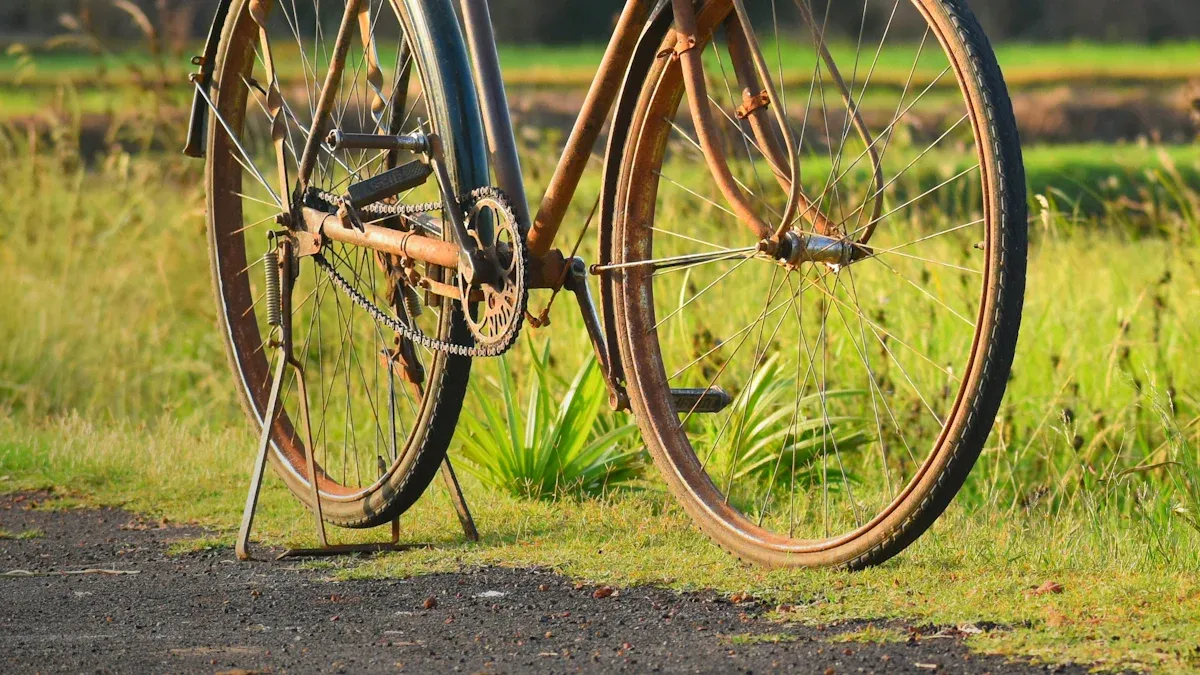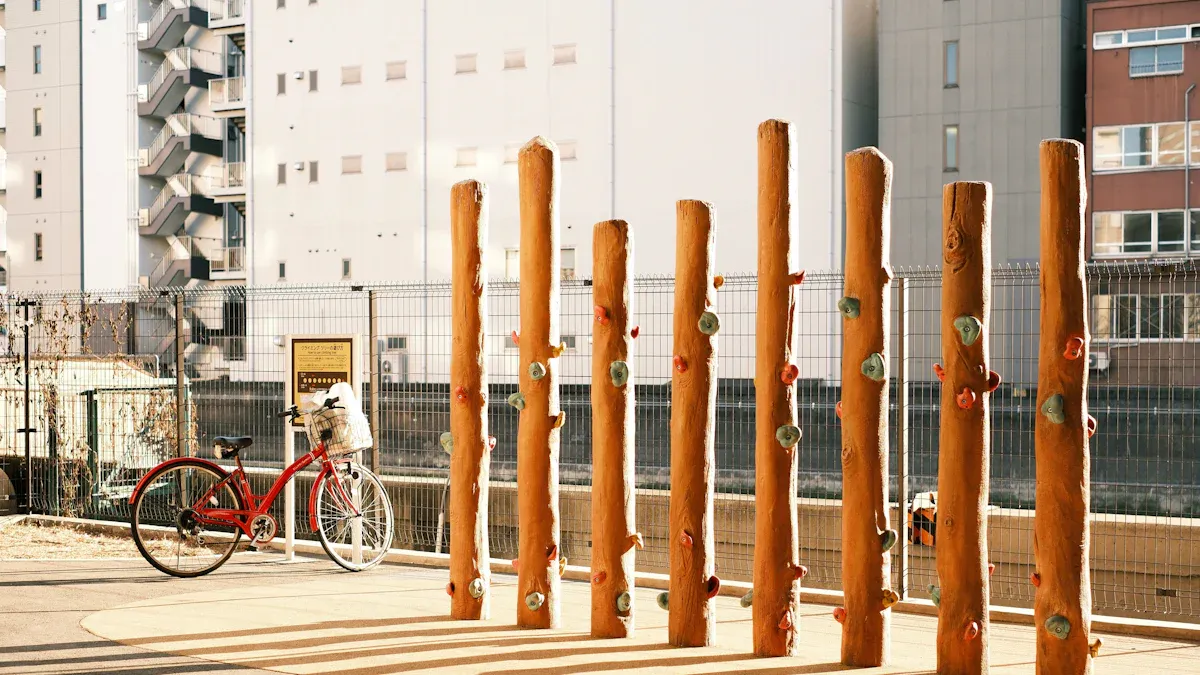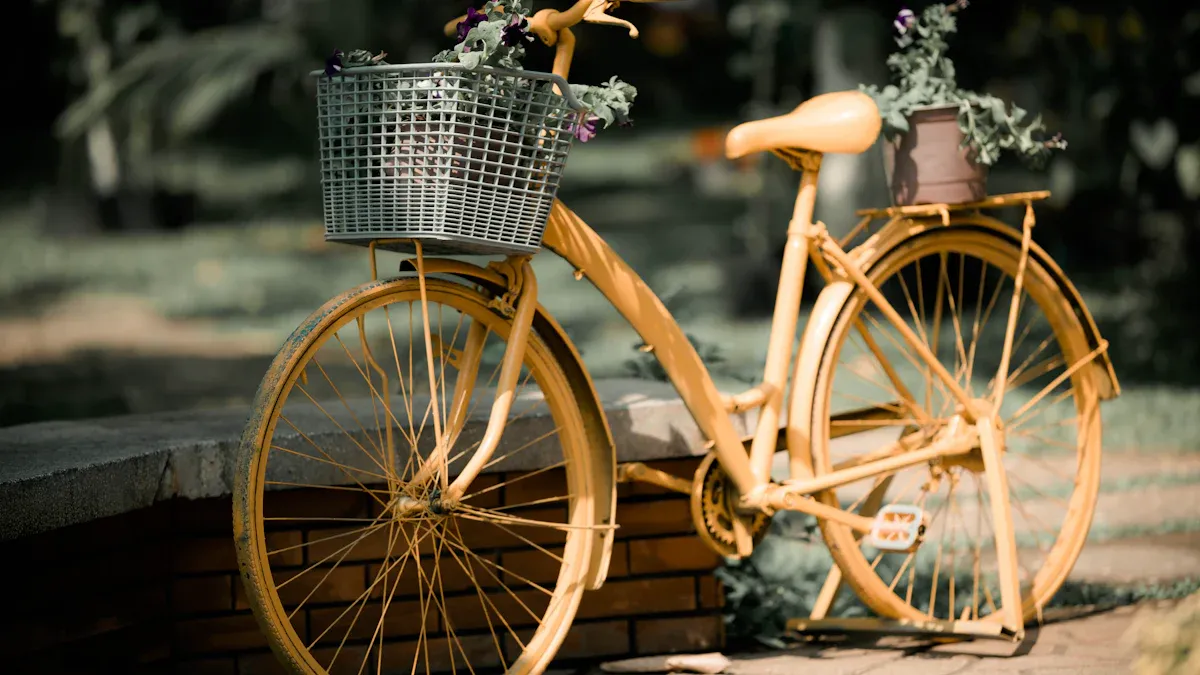
You can make a bamboo bike frame at home with simple tools. You need to be patient and pay close attention to details. Many beginners have trouble fitting the bamboo tubes together. Wrapping the joints tightly can also be hard. Sanding the frame to make it smooth takes time. Finding good bamboo is not always easy. Sometimes the bamboo has cracks or is not shaped right. Even with these problems, bamboo is good for the environment.
Bamboo frames need less energy to make than metal frames. Bamboo also stores carbon, which helps lower greenhouse gases. Using bamboo helps the planet because it is a renewable material. If you are just starting, kits and guides can help you a lot. They make building the frame easier and more fun.
Key Takeaways
Choose strong, mature bamboo and heat-treat it to prevent cracks and pests.
Use simple tools and consider kits to make building easier and more fun.
Align and fit bamboo tubes carefully, then wrap joints tightly with fiber and epoxy for strength.
Sand and seal the frame well to protect it from moisture and give it a smooth finish.
Always check your bike for safety before riding and test it to fix any issues early.
Planning and Materials

Frame Design
When you design a bamboo bike frame, you need to think about how you want the bike to ride. You should match the frame size to your body for comfort and control. If you want a smooth ride, you can use bamboo’s natural ability to absorb bumps and vibrations. You also need to balance stiffness and flexibility. Too much stiffness can make the ride harsh, but too much flex can make the bike feel weak.
Tip: Test your design by making a full-size mock-up with PVC pipes. This helps you check measurements and angles before you cut any bamboo.
Here are some important things to consider:
Choose a frame shape that fits your riding style, like road, mountain, or city.
Make sure the joints are strong to avoid weak spots.
Use real-world testing to improve comfort and durability.
Seal the bamboo to stop it from splitting when the weather changes.
Tools and Parts
You do not need fancy tools to build a bamboo bike frame. You can use many things you might already have at home. Here is a list of what you need:
Saw, knife, and drill
Sandpaper and file
Epoxy resin and hardener
Hemp or carbon fiber for wrapping joints
Propane torch (for heat treating bamboo)
Rubber gloves and electrical tape
Aluminum angle bar, threaded rods, and nuts (for a simple jig)
Spar varnish for sealing
Old bike frame parts (for lugs and alignment)
Note: Many beginners use bamboo bike frame kits. These kits give you pre-cut bamboo, jigs, and clear instructions. They help you avoid mistakes and make the process easier.
Frame Parts
You will reuse some parts from an old steel bike frame. These parts help you fit standard bike components. The most common donor parts include:
Head tube
Rear dropouts
Fork
Seat tube (top section)
You can see the typical specifications in the table below:
Component | Specification |
|---|---|
Bottom Bracket | |
Crankset | 44 – 48 Teeth (single or multiple) |
Freewheel/Cassette | 18 – 22 Teeth (8-10 speed cassette) |
Rim Size | 700c |
Tire Size | 700x28c to 700x32c |
Fork Size | 700 Over 1 1/8 Straight – threadless |
Headset | Over External 1 1/8 (31.8mm) |
Seat Post | 27.2mm |
Seat Clamp | 31.8mm Bolt |
You can use these parts to make sure your bamboo bike frame fits regular bike parts. This makes repairs and upgrades much easier.
Preparing Bamboo
Selecting Bamboo
You need to choose the right bamboo for your bike frame. Look for mature bamboo culms that are at least three years old. Mature bamboo has better strength and lasts longer. Species like Pseudosasa amabilis (Tonkin Cane) and Pleioblastus amarus (Ku Zhu) work well because they have a high strength-to-weight ratio. Younger bamboo is weaker and can break more easily. Moisture affects bamboo, so pick pieces that feel dry and solid. Avoid bamboo with cracks, mold, or soft spots.
Tip: Store bamboo in a dry place before you start building. This helps prevent future problems with moisture.
Heat Treating
Heat treating bamboo makes it stronger and keeps bugs away. Use a propane torch or small flame to heat the bamboo slowly. Move the flame along the tube until the color changes from green to tan or brown. This process hardens the sugars inside, making the bamboo stiff and less attractive to pests. Heat treatment also removes moisture, which helps prevent cracking and splitting. You can also bake the bamboo in an oven to remove extra moisture. Always let the bamboo dry well after heating.
Heat treatment kills pests and hardens the bamboo.
It reduces the risk of mold and splitting.
Proper sealing after heat treatment protects your bamboo bike frame from moisture.
Cutting Tubes
Cutting bamboo tubes to the right size is important for a good fit. Use a fine-toothed saw, such as a Japanese pull saw, for clean cuts. For angled cuts, a miter saw or radial saw gives you better control. Always wear gloves and eye protection when cutting. Mark your measurements with a sharp pencil and use a metal ruler for accuracy. For shaping joints, use a round-tip chisel or a sharp knife. Take your time to make sure each tube fits snugly with the others.
Note: Clean, precise cuts help your frame stay strong and look professional.
Bamboo Bike Frame Assembly

Frame Jig Setup
You need to keep your frame parts in the right position while you build. You can use a homemade wooden jig or a donor steel frame for this step. A wooden jig costs less and lets you change the design. You can build it from 2x4s and adjust it for custom shapes. This method gives you control, but you must check the alignment often. You need to line up the bottom bracket, head tube, and dropouts very carefully. The jig holds the tubes in place, but you must use your eyes and measuring tools to make sure everything stays straight.
A donor steel frame makes things easier. You use the old frame as a guide. This keeps the geometry correct and saves time. You do not have to build a jig from scratch. If the lugs and parts are in good shape, you can fit your bamboo tubes right into the donor frame. This method works well if you want a standard bike shape and do not need custom changes.
Tip: If you want to try new designs, use a wooden jig. If you want a simple build, use a donor frame.
Tube Alignment
Getting the tubes lined up is one of the most important steps. Good alignment helps your bamboo bike frame last longer and ride better. If the tubes are not straight, the frame can break or feel strange when you ride. Even a small mistake can cause cracks or weak spots.
You can follow these steps for precise tube alignment:
Shape the ends of the tubes with a sanding drum or file. Make a fish-mouth notch so the tubes fit tightly together.
Dry-fit the tubes before gluing. Check the angles and make small changes until everything lines up.
Sand the bamboo after heat treating. This removes any wax and helps the glue stick.
Use overlapping joints at the bottom bracket and head tube. This makes the frame stronger.
Check the alignment with a ruler or straight edge. Make sure the dropouts, head tube, and seat tube are all in line.
Note: Careful alignment spreads the weight evenly and keeps your bike safe. Always double-check before you glue.
Joint Wrapping
Wrapping the joints gives your bamboo bike frame its strength. You use fibers like hemp, flax, or carbon fiber, soaked in epoxy resin. This method comes from aeronautics and nature. The fibers hold the tubes together and let the frame handle bumps and hard turns.
Start by tacking the tubes in place with a small amount of epoxy. Once the tubes are set, wrap the joints with your chosen fiber. Use a wet layup technique. This means you soak the fiber in epoxy and wrap it tightly around the joint. Make sure every layer is wet and smooth. Add several layers for extra strength. After wrapping, let the epoxy cure fully. Sand the joints to make them smooth, then add more layers if needed.
Fiber wrapping gives the joint most of its strength. It can hold up to 1-2 tonnes per joint.
Epoxy resin fills gaps and seals the bamboo, but the fiber does the real work.
Wrapping protects the joints from water and keeps the frame strong in all weather.
Using natural fibers like hemp or flax makes the frame eco-friendly. Carbon fiber gives extra stiffness for high-performance bikes.
Alert: Take your time with joint wrapping. Rushing can lead to weak spots or messy joints.
Patience and careful work during assembly help you build a bamboo bike frame that is strong, safe, and ready for the road.
Finishing and Safety
Sanding Joints
You want your bamboo bike frame to look smooth and professional. Start sanding the joints by hand after the epoxy has cured overnight. Begin with coarse grit sandpaper to remove rough spots and shape the joints. Move to finer grits as the surface gets smoother. This process takes time, but it is important for both strength and appearance. Sanding removes the waxy layer from the bamboo, which helps the epoxy stick better and makes the joints last longer. Use rasps or a dremel for shaping, then finish with sandpaper for a clean look. After sanding, apply extra coats of epoxy to the joints. Finish with a UV-resistant varnish or surfboard epoxy for protection and shine. Multiple coats, such as three layers of epoxy and two clearcoats, help your frame stay strong and look great.
Tip: Careful sanding before and after wrapping the joints gives you sharp, clean edges and a polished finish.
Component Installation
Now you can install the bike parts. Prepare the metal pieces like the bottom bracket shell, head tube, and dropouts. Make sure they fit well and line up with the bamboo tubes. Use shims or metal inserts for the seat tube to prevent cracks. Start by tacking the bamboo tubes in place with epoxy, then wrap the joints with fiber and let them cure. Check the clearance around the rear sprocket so the chain moves freely. Fit the seat post using bamboo shims if needed, and reinforce the area with fiber. Attach cable stops for the brakes and gears. Finally, assemble the standard bike components, such as the crank, pedals, fork, and derailleur, using regular bike tools.
Safety Check
Before you ride, check every part of your bamboo bike frame. Make sure all bolts are tight and use thread locker to keep them from loosening. Look for any gaps or cracks in the joints. Test the brakes and gears to see if they work smoothly. Check the bottom bracket area for enough clearance, especially if you plan to ride hard or climb hills. If you hear creaking or feel looseness, stop and fix the problem before riding farther.
Alert: Never skip the safety check. A careful inspection keeps you safe and helps your bike last longer.
Test Ride
Take your bike for a short test ride. Listen for any strange noises, like creaking from the seatpost or joints. Pay attention to how the bike feels. If the frame feels too flexible or unstable, check the tube sizes and joint wraps. Make small adjustments to the bolts and components as needed. Some issues, like a loose bolt or a noisy seatpost, may show up only during a ride. Fix these problems right away. After a few rides, check the frame again for any new cracks or wear.
Note: Test rides help you find and fix small problems before they become big ones.
Making your own bike frame is a fun project. You get to learn new things and feel proud of your work. Your bike will be special and good for the planet. Go slowly and wear safety gear every time. You can find help and advice online from other builders. Sharing what you do helps others and lets you meet new friends. Workshops and kits make building easier for people just starting. If you are careful and patient, your bike will last a long time.
FAQ
How strong is a bamboo bike frame?
Bamboo can be as strong as steel for bike frames. You get a frame that handles daily rides and rough roads. Proper wrapping and epoxy make the joints tough. Always check your frame for cracks before riding.
Can I use any type of bamboo?
No, you need mature, dry bamboo with thick walls. Look for species like Tonkin Cane. Avoid bamboo with cracks or mold. Good bamboo keeps your frame safe and long-lasting.
What tools do I need to build a bamboo bike frame?
You need basic tools:
Saw
Drill
Sandpaper
Epoxy resin
Fiber for wrapping
Kits often include most tools and clear instructions.
How do I stop bamboo from cracking?
You must heat-treat the bamboo and seal it with varnish or epoxy. Store bamboo in a dry place. Check for cracks before you build. Sealing keeps moisture out and helps prevent splits.
Is a bamboo bike frame safe to ride?
Yes, if you build it carefully and check all joints. Test the bike before long rides. Always inspect for loose parts or cracks. Safety checks help you ride with confidence.
See Also
Learn How To Draw Bike Frames With Simple Steps
Must-Have Tools And Supplies For Crafting Bike Frames
Experiencing The Ups And Downs Of Wooden Bike Frame Construction
